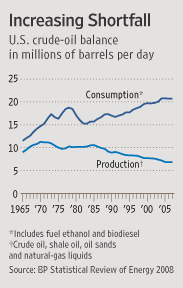How Would You Spend Your Daily 100 watts?
by Charles Hugh Smith
Instead of sending money every month to the local utility, what if you spent that sum on solar panels? How much power would you be generating for your household? How would you "spend" that electricity?
Readers often request more focus on solutions, as opposed to more doom-and-gloom dissection of our current mire of corrupt crony capitalism dependent on cheap oil and an exponential increase in debt.
Correspondent Joe H. offers us a question which leads directly to pondering solutions which are in our own hands.
The vast majority of us send money to the local utility for electricity every month. What if we invested that same sum in our own power generation? It's called "owning the means of production" in a quasi-Marxist perspective, "self-sufficiency" in another context, and "Yankee ingenuity"--a concept which has almost been lost in our self-indulgent, entitlement culture which looks to sell-your-soul-to-the-Devil "financial innovations" as the "solution" to our problems.
Here is Joe's commentary:
Starting point: Re-read The Art of Survival, Taoism and the Warring States (June 27, 2008):I have often found it valuable to attack problems from "the other direction." If I cannot pull a gear off a shaft, can I drive the shaft out of the gear? If I cannot develop a plan to resource a my project, can I reconfigure the project to fit the resources? If I get mentally stuck trying to reconfigure the project to fit the resources, then can I zero-base the project to fit under the umbrella?
It is depressing to anticipate the path we would likely take from here. One common topic is Peak Oil so let's stand that problem on it's head and see if knowing becomes less of a burden. To keep the exercise manageable, let's play with home based solar systems using the zero-based approach.
What activities can 10 Watts perform? What activity(s) would most people choose? The answer seems pretty clear: Cell-phones and other wireless, mobile technologies. Need entertainment? It is in your hand. Need a weather report? Ditto. Need to tell your spouse to pick up milk at the store? Done. Need to perform some simple math calculations? Piece of cake.
Second choice: Some LED lighting applications if there is extra capacity.
The next step up is a big one.
There is a historical precedence that the cost of one's tools should not exceed one year's wages that you could earn with those tools. One explanation for the basis of this rule-of-thumb was that apprentices were expected to spend 25% of their 4 year apprenticeship making their own tools. An apprentice blacksmith would start with the very simplest tools (a hammer, perhaps) and toward the end of his apprenticeship would be making intricate tongs and heat-treated chisels. Using this rule-of-thumb, how much capacity would one year's electric bill buy, and what would you dedicate that capacity toward?
Using this handy-dandy calculator I learned that mindless Watt-for-Watt replacement will cost me approximately 13 years worth of electric bills. That suggests that the cost of one year's electric bills would supply approximately 1/20th of my current usage! If my math is correct, that works out to 200 Watts during the daylight hours or 100 Watts over 24 hours.
Cell phones, lap-top, LED lights, sump-pump (emergency), water pump (intermittent), and a ceiling fan (summer) are about all I could probably manage. The furnace is gone because it has a huge blower motor and winter, in Michigan, has terrible solar availability. Wood-stove is the way to go.
Good-bye electric hotwater heater. Good-bye electric clothes drier.
Aside: The greatest blow an individual American family can strike against terrorism is to buy 100 feet of clothes line, 200 clothes pins and to use them! Huge benefit would accrue even if we just hung out the big, heavy stuff like jeans, towels, sweat-shirts, sheets, blankets.
So this is where I invite your readership to participate. How would you budget 100 Watts over 24 hours to maximize your life's utility and enjoyment?
Thank you, Joe, for a thought-provoking question.
Just as a larger context for the question, here is a chart depicting the intersection of four great macro-trends:

In responding to Joe's question, I would immediately grant that as he mentions, northern states might not receive enough bright sun annually to justify a solar array on strictly financial terms.
But as I argue in Survival+, there is value in control of assets and production which is not easily quantified. Even if a solar array only generates power during the summer months, it is within your control. That's valuable.
Or the investment in "tools" Joe describes could be made in other technologies more suitable for cold climes, such as geoexchange heating. The Earth is about 50-55 degrees F. some feet down; drill a deep narrow shaft, run a pipe down and use the Earth's latent heat to warm water to 50 F. The water then need be heated only 10-15 F to warm the house to a comfortable ambient temperature.
Reverse the process in hot summers. Water at 50 F will cool a house quite well.
Yes, you need a small pump to circulate the water. Hmm, how about 100 watts?
Add in some (comparatively cheap) insulation and glazing films and the 50% of the nation's energy consumed heating and cooling buildings drops considerably--at least in your house.
Solutions abound, both at the macro and household level. Are they easy or cheap? No. But that's not the same as saying they don't exist.
| Thank you, Derek L. ($45), for your exceptionally generous contribution to the site--it is an honor to be supported by an active-duty member of the U.S. Armed Forces. I am greatly honored by your support and readership. | Thank you, Wayne L. ($5), for your very generous donation to the site. (Every donation is extremely consequential.) I am greatly honored by your support and readership. |




























